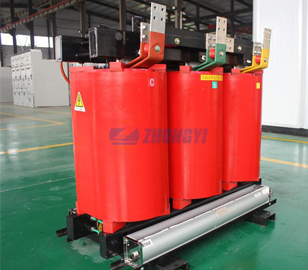Jun. 24, 2021
What is the difference between a dry-type transformer and an oil-type transformer? In the field of construction engineering, the transformer is one of the indispensable pieces of equipment in power system transmission and distribution engineering. It is important equipment to change the voltage level, reduce the loss of electric energy in the transmission process and ensure the safety of electricity consumption. Power transformers are divided into oil-immersed transformers and dry-type transformers according to the different cooling media.
Oil-immersed transformers consist of cores, windings, and bushings. The magnetic core provides the path for the magnetic flow. The winding produces the magnetic field and consists of a conductor coil wound around the core and insulated with a cardboard barrier and screen. The thickness of the winding insulation increases as the voltage increases. The bushing connects the transformer windings to the substation. A feature of oil-immersed transformers is the oil storage cabinet. It simplifies operation by monitoring the oil level in the tank and providing space for the thermal expansion of the oil.
Oil-immersed transformers are transformers that use transformer oil as the heat dissipation medium. Oil-immersed transformers have been used in power systems for centuries in transmission and distribution projects. Oil-immersed power transformers have become one of the most widely used electrical equipment in the world because of their simple structure, long history, rich manufacturing operation and reliable operation. Most of the transformers operating in the power system are oil-immersed transformers. Dry-type transformers, as the name implies, are transformers that use air instead of transformer oil as the heat dissipation medium.

Dry-Type Transformer
Dry-type transformers are widely popular because of their oil-free and reduced fire resistance rating requirements for buildings. However, in some special environments, only dry-type transformers can be used, such as "multi-story or high-rise main buildings". Therefore, in many places where oil-immersed transformers are not allowed to be used, such as underground and high-rise buildings, where fire resistance requirements are high, dry-type transformers can be designed.
At present, epoxy resin casting dry type transformer overcomes the problems of low heat resistance level of insulation material and easy aging and cracking of insulation material. With the continuous development of insulation materials and the improvement of material performance, the insulation heat resistance grade can reach H grade, which is a technical index that oil-immersed transformers cannot reach. Secondly, compared with the traditional oil-immersed transformers, dry-type transformers have many advantages such as oil resistance, fire resistance, dust resistance, moisture resistance and small partial discharge.
Dry-type transformers mainly consist of an iron core and epoxy resin casted coils made of silicon steel sheets. The insulating cylinder is placed between the high and low voltage coils to increase electrical insulation, and is supported and restrained by gaskets. The fasteners of the parts have anti-loosening properties.
Dry-type transformers work on the same principle as other transformers, following the physical principles of voltage technology required for the use of electrical and magnetic coupling: When current flows through the wire's current, a changing magnetic field or "magnetic" around it is generated. The wire fluctuates around the magnetic field and the current it generates in the wire. Thus, there will be fluctuating magnetic fields in the second wire and in the first wire, and the current will flow inductively in the second wire. Electricity passes through two conductors that are not actually in contact with each other.
First, dry-type transformers have the advantage of being oil-free and bulky, reducing the fire hazard. Investments in fire prevention can be reduced; corresponding investments in disaster prevention and civil construction can be saved. Moreover, since dry-type transformers do not have oil leakage problems, it reduces the maintenance work of transformer daily operation and does not require oil change if regular oil aging detection is not required. This greatly reduces the cost of daily maintenance.
Contact Us
Contact us. Together with us, inspire boundless creativity
NAVIGATION
Tel: +86 312 5880165
Mob: +86 135 1322 2010
Fax: +86 312 5880165
E-mail: gracejia@zydqjt.com
Skype: +86 135 1322 2010
WhatsApp: +86 135 1322 2010
Wechat: +86 135 1322 2010
FOLLOW US
Add: Room A1109, No.483 Yulan Street, Baoding City, Hebei Province, China
